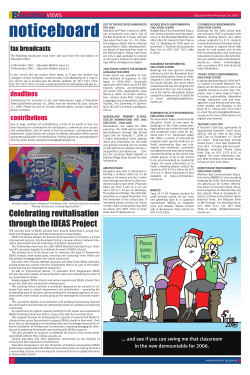
Food Handling - Education Queensland
Food Handling Activity scope This guideline relates to Food Handling as a curriculum activity. Food handling refers to the storage and assembly of raw or cooked ingredients, but not cooking as an activity. Demonstrations undertaken by teachers should exemplify safe and hygienic procedures and practices. For activities involving cooking, read this in conjunction with the Cooking and Maintaining a Safe Kitchen guideline. Minimum supervision • Ensure there is adequate adult supervision. Student numbers should be determined by the risk of the activity and equipment and implements used, and age and ability of the students. Risk level • Low risk: Use of non-electrical equipment and implements that will not cause injury unless deliberately misused. • Medium risk: Use of electrical appliances and cutting or garnishing tools that could cause injury if insufficient training or supervision is provided. Minimum activity-specific qualifications for supervisors Low risk level • For a registered teacher: o • competence (knowledge and skills) in food hygiene and handling, safety procedures, and supervising students in low-risk food handling activities, OR For a leader other than a registered teacher, an adult with equivalent competence. Medium risk level • For a registered teacher: o • competence (knowledge and skills) in food hygiene and handling, safety procedures, supervising students in medium-risk food handling activities, and in the use of any equipment required for the activity, OR For a leader other than a registered teacher, an adult with equivalent competence. Minimum activity-specific equipment/facilities • The location for food handling activities should meet all of the requirements for a safe kitchen as set out in Cooking and Maintaining a Safe Kitchen. • If the activity is not occurring in an identified kitchen i.e. in a classroom, the same general principals in relation to hygiene and equipment apply. • Appropriate personal protective equipment including covered non-porous shoes and protective clothing. Activity-specific hazards/risks and suggested control measures • Ensure that all food items used comply with Australia New Zealand food standards and are not subject to any current food recalls. • Inspect equipment before use for cracks and other damage. • Instruct students in the safe handling of food and equipment. Cooking - Cutting Rolls, File # 3192988 iStockphoto © LUGO Date modified: 16 March 2015 • Arrange equipment, tools, appliances and furniture so that staff and students are able to see all work areas clearly, have ready access and can work freely on their activity. • Do not use extension cords to connect appliances if they constitute a tripping hazard or cause an obstruction. • Give careful consideration to the number of people involved in any activity. Overcrowding, insufficient staffing or unworkable task allocation will increase the potential for an accident. • Consider whether some activities should only be undertaken by the teacher/leader or senior students. • Adhere to the Guide to Managing Electrical Safety in Schools. • Use cleaning agents at the minimum strength necessary to maintain hygienic surfaces. • Put procedures in place to immediately manage the removal of all spilt substances. • Ensure the same equipment is not used for raw meat, chicken and fish as for other foods that will not be cooked (e.g. salads). • Do not allow students to share tasting equipment. • Use appropriate equipment when heating or cooling materials quickly. • Ensure equipment and implements are stored safely when not in use. Useful activity-specific links • Cooking and Maintaining a Safe Kitchen — CARA activity guideline http://education.qld.gov.au/curriculum/carmg/pdf/maintaining-safe-kitchen.pdf • Electrical Safety Guidelines http://education.qld.gov.au/health/pdfs/healthsafety/electrical-safety-guide.pdf • Food Experimentation — CARA activity guideline http://education.qld.gov.au/curriculum/carmg/pdf/food-experimentation.pdf • Food Standards – Australia and New Zealand http://www.foodstandards.gov.au/ • Smart Choices – Healthy Food and Drink Supply Strategy for Queensland Schools http://education.qld.gov.au/schools/healthy/food-drink-strategy.html • Food safety: preventing food poisoning http://www.qld.gov.au/health/staying-healthy/environmental/food/index.html Disclaimer: This document is developed and distributed on this website by the State of Queensland for use by Queensland state schools. Use or adaptation of, or reliance on, this document or information in this document by persons or organisations other than the State of Queensland is at their sole risk. All users who use, adapt or rely on this document or any information in this document are responsible for ensuring by independent verification its accuracy, currency and appropriateness to their particular circumstances. The State of Queensland makes no representations, either express or implied, as to the suitability of this document or the information in this document to a user’s particular circumstances. To the full extent permitted by law, the State of Queensland disclaims all responsibility and liability (including without limitation, liability in negligence) for all expenses, losses, damages and costs arising from the use or adaptation of, or reliance on, this document or any information in this document. Links in this document to external websites are for convenience only and the State of Queensland has not independently verified the information on the linked websites. It is the responsibility of users to make their own decisions about the accuracy, currency, reliability and correctness of the information at these external websites. Uncontrolled when printed Food Handling — Page 2 of 2
© Copyright 2025





















